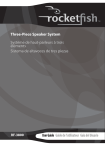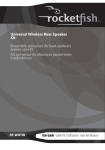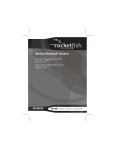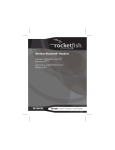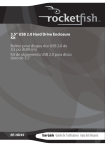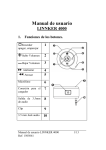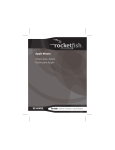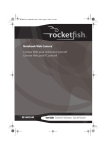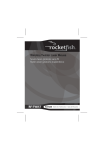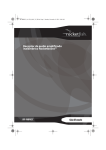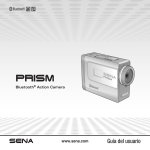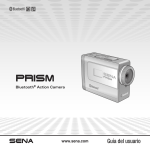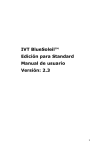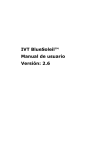Download RocketFish RF-BTCMBO User guide
Transcript
Bluetooth Keyboard and Mouse Combo Ensemble clavier et souris Bluetooth Combo de Teclado y Ratón Bluetooth RF-BTCMBO User Guide Guide de l’utilisateur Guía del Usuario Rocketfish RF-BTCMBO Bluetooth Keyboard and Mouse Combo Contents Introduction ...................................................................... 2 Features............................................................................... 3 Identifying components ............................................... 4 Using the keyboard and mouse ................................. 9 Troubleshooting ............................................................23 Legal notices ...................................................................24 Warranty ...........................................................................27 Français.................................................. 29 Español .................................................. 57 Introduction Congratulations on your purchase of a Rocketfish Bluetooth keyboard and mouse. This guide explains how to correctly operate and get the best performance from your wireless keyboard and mouse. Read this user guide carefully before using your product, then keep it next to your computer for quick reference. 2 Features Package contents Before you start using your keyboard and mouse the first time, verify that your package contains the following: • • • • • • Keyboard Laser Mouse USB Bluetooth dongle One installation CD Batteries for the keyboard and mouse This user guide If any item is missing or damaged, contact Rocketfish at (800) 305-2204. Features Keyboard and Laser Mouse • Keyboard • 104-key design • Ten frequently used hotkeys • One connect button • Laser mouse • Tilt/scroll wheel • Three mouse buttons (left, right, and middle buttons) • Four media key buttons • One pairing button • Power-saving mode • Excellent performance • Working range up to 30 feet (10 meters) line-of- sight • Dual-color status LED indicator RF-BTCMBO 3 USB Bluetooth dongle • • • • One pairing button Bluetooth specification v1.0 and v2.0 compliant Supports both keyboard and mouse Supports additional Bluetooth devices System requirements • PC with a USB port • Microsoft Windows 2000, XP, or Vista Identifying components Keyboard top 6 1 2 3 4 5 Number 4 7 8 9 10 11 Icon Description 1 Home button 2 Search button 3 E-mail button 4 Increase volume button 5 Decrease volume button Number Icon Description 6 Status LED 7 Play/Pause button 8 Stop button 9 Next track button 10 Previous track button 11 Mute button Keyboard bottom 1 Number Icon Description 1 Connect Connect button RF-BTCMBO 5 Laser mouse 1 2 3 6 4 5 6 7 8 Number Description 1 2 3 4 5 6 7 8 9 Left button Stop button Previous track button Tilt/scroll wheel button Play/pause button Next track button Right button Status LED Pairing button 9 Note: The keyboard hotkeys and the mouse media key buttons are disabled by default. To use these hotkeys and buttons, you need to install the Bluetooth WIDCOMM stack as described in “Installing the WIDCOMM Bluetooth stack” on page 12. Note: To enable the horizontal scrolling, you need to install the Bluetooth Mouse software on your computer. See “Installing the Bluetooth mouse software“ on page 17 for more information. Keyboard and mouse status LED Color Description Green Flashing red Flashing red and green Mouse is turned on, battery level normal. Low battery Mouse/keyboard pairing Battery status You can view more detailed information on the keyboard and mouse battery status. To view more detailed information on the keyboard battery status: • Click Start, Control Panel, Keyboard, then click Bluetooth. RF-BTCMBO 7 To view more detailed information on the mouse battery status: • Click Start, Control Panel, Mouse, then click Bluetooth. To change the settings for the low battery alarm: 1 In the Keyboard Status dialog box or the Mouse Status dialog box, click the Low Battery Alarm button to open the following dialog box. 2 Change the settings according to your preferences. 8 Using the keyboard and mouse Installing the batteries The keyboard and mouse both need two AA alkaline batteries. Complete the following steps to install the batteries. Keyboard To install the keyboard batteries: 1 Remove the battery cover as shown. RF-BTCMBO 9 2 Install two AA batteries according to the polarity (+ and -) marks indicated inside the compartment. 3 Replace the battery cover. 10 Laser mouse To install the laser mouse batteries: 1 Press the tab to release the battery cover, then remove it. 2 Install two AA batteries according to the polarity (+ and -) indicated inside the compartment. RF-BTCMBO 11 3 Replace the battery cover. Installing or uninstalling the WIDCOMM Bluetooth stack Installing the WIDCOMM Bluetooth stack To install the WIDCOMM Bluetooth stack: 1 Plug the USB Bluetooth dongle into a USB port on your computer. 2 Insert the provided installation CD in the CD or DVD drive. The installation stack loads automatically. Note: If the installation stack does not load automatically, double-click Setup.exe in the bin folder of the installation CD. The Welcome Screen introduces you to the installation process. 3 Follow the on-screen prompts to complete the WIDCOMM Bluetooth Software wizard. Note: If the “Bluetooth device not found” message appears, plug the USB Bluetooth dongle into a USB port on your computer, then click OK. The Found New Hardware Wizard starts installing the components for the USB Bluetooth dongle. 4 After the wizard finishes, remove the dongle and plug it back in. The keyboard and mouse pair automatically. 5 Click Finish to exit the installation. 6 In Windows 2000, a prompt requires you to restart the computer so that the Bluetooth stack takes effect. Click Yes to restart your computer now or No to restart later. 12 Uninstalling the WIDCOMM Bluetooth stack To uninstall the WIDCOMM Bluetooth stack: 1 Remove the USB Bluetooth dongle. 2 In Windows Vista, click Start, Control Panel, then click Programs and Features. In Windows 2000 or Windows XP, click Start, Settings, Control Panel, then click Add/Remove Programs. 3 Click WIDCOMM Bluetooth Software from the program list, then click Uninstall (Windows Vista) or Remove (Windows 2000 or Windows XP). A confirmation message appears. 4 Click Yes to uninstall or No to cancel. When the program has been removed, a prompt requires you to restart the computer. 5 Click Yes to restart your computer now or No to restart later. Setting up the keyboard and laser mouse Automatic pairing in Boot mode RF-BTCMBO 13 To enable the keyboard and mouse in boot mode: 1 With your computer turned off, plug the USB Bluetooth dongle into an available USB port. 2 Slide the power switch of the mouse to turn the mouse on. 3 Press the button on the bottom of the USB Bluetooth dongle until the LED begins to flash once every second. This indicates the Bluetooth dongle has started to search for a device to be paired with. The Bluetooth connection is established. 4 Turn on the computer and use the keyboard to enter the BIOS setup. 5 Use the keyboard and mouse to view the menu and configure the settings. Enabling the USB keyboard and mouse function in BIOS If the keyboard or mouse failed to work, verify that the USB keyboard and mouse function has been enabled in the BIOS setup. Note: See “Troubleshooting” on page 23 for additional troubleshooting information. To enable the keyboard and mouse in BIOS: 1 Make sure the Bluetooth connection has been established before turning on your computer. 2 Turn on your computer, then follow the on-screen instructions to enter the BIOS setup. 3 Use the cursor keys on the keyboard to navigate through the menu items and enable the USB keyboard and mouse function. (In some BIOS settings, you can use the Bluetooth mouse to navigate through the items.) Note: Some older PC systems do not support the USB keyboard and mouse in a BIOS or DOS environment. Quick pairing in Windows The Bluetooth keyboard and mouse have been set to a pre-pairing mode as the factory default. For quick pairing, enable the pre-pairing mode following these steps. To enable pre-pairing mode: 1 Plug the USB Bluetooth dongle into a USB port on your computer. The first time you connect the keyboard or mouse to your computer, the Found New Hardware Wizard launches automatically. Cancel the Wizard, then follow these steps. 14 2 For the mouse, press the pairing button on the bottom of the mouse. For the keyboard, press and hold the connect button on the back of the keyboard for two seconds. 3 Press the button on the bottom of the USB Bluetooth dongle until the LED begins to flash once every second. This indicates the Bluetooth dongle has started to search for a device to be paired with. USB Bluetooth dongle button Note: When pairing, the keyboard/mouse LED flashes red and green. Note: The pairing settings are cancelled if you press the mouse pairing button or the keyboard connect button. To reconnect the mouse or keyboard, press the USB Bluetooth dongle button again (Refer to Step 3). 4 Press any key on the keyboard and move your mouse to make sure that they are connected. Note: Each time you turn on your computer, the keyboard and mouse are automatically detected. Pairing using the WIDCOMM Bluetooth stack Before using the Bluetooth stack for keyboard and mouse pairing, make sure of the following: • The WIDCOMM Bluetooth stack is installed and set up as instructed in “Installing the WIDCOMM Bluetooth stack” on page 12. • The batteries are inserted properly and fully charged. • The USB Bluetooth dongle is plugged into a USB port on your computer. • The mouse is turned on. Note: To start the Bluetooth stack for the first time, see “Using the stack for the first time in Windows 2000 or Windows XP“ on page 20 for more information. RF-BTCMBO 15 To pair using the Bluetooth stack: 1 Press the Connect button on the mouse and keyboard to start pairing. 2 Press the USB Bluetooth dongle button until the Human Interface Device (HID) screen appears. Your computer starts to search for all Bluetooth devices. When the connection to the mouse is established, this message appears: 3 Click to confirm that the mouse is connected. 16 When the connection to the keyboard is established, this screen appears: 4 Use the paired keyboard to type the digits shown on the screen, then press the Enter key. The keyboard is connected. Note: The Bluetooth security code changes each time the keyboard is connected. Note: The keyboard and mouse enter the power saving mode when not used for a period of the time. Using the Bluetooth mouse software Installing the Bluetooth mouse software To install the Bluetooth mouse software: 1 Make sure the WIDCOMM stack has been installed on your computer. 2 Plug the USB Bluetooth dongle into an available USB port on your computer. 3 Insert the provided installation CD in the CD or DVD drive. The software starts automatically. Note: If the software does not load automatically, double-click Setup.exe in the bin folder of the installation CD. RF-BTCMBO 17 4 Complete the Bluetooth Mouse Setup wizard to install the Bluetooth mouse software. 5 Restart your computer before using the Bluetooth mouse software. Uninstalling the Bluetooth mouse software To uninstall the Bluetooth mouse software: 1 Remove the USB Bluetooth dongle. 2 In Windows Vista, click Start, Control Panel, then click Programs and Features. In Windows 2000 or Windows XP, click Start, Settings, Control Panel, then click Add/Remove Programs. 3 Select Bluetooth Mouse from the program list, then click Uninstall (Windows Vista) or Remove (Windows 2000 or Windows XP). A confirmation message appears. 4 Click Yes to uninstall or No to cancel. Adjusting the tilt/scroll wheel speed Your mouse comes with an advanced scroll wheel that enables horizontal window scrolling as well as vertical scrolling. 18 To adjust the scrolling wheel speed: 1 Right-click the Mouse icon in the system tray, then click Adjust Property. The Bluetooth Mouse Property dialog box opens. 2 To set the vertical scroll speed, select one of the following, then click OK. Selection Description Scroll x lines per notch Select to set the number of lines to scroll when the scroll wheel is moved one notch. Specify the number of lines with the up and down arrows. Scroll one screen per notch Select to scroll the entire window when the scroll wheel is moved one notch (page up/page down). 3 To set the horizontal scroll speed, move the slider toward Slow or Fast or click Use Default to restore the factory settings, then click OK. RF-BTCMBO 19 Using the WIDCOMM Bluetooth stack Using the stack for the first time in Windows 2000 or Windows XP To start using the Bluetooth stack: 1 Double-click the Bluetooth icon in the system tray. The Initial Bluetooth Configuration Wizard opens. 2 Follow the on-screen instructions to complete the configuration. 20 When the Bluetooth configuration is complete, the following dialog box appears and starts to search for Bluetooth devices. 3 Click on the HID device you want to connect with, then follow the on-screen instructions to enable the selected device. Interpreting the Bluetooth icon The Bluetooth icon acts as an indicator for dongle status. Icon color Indicates Red White Green No dongle inserted Dongle is plugged in Dongle has detected the devices Connecting to other devices in Windows 2000 and Windows XP The Bluetooth stack allows you to connect to other Bluetooth devices. RF-BTCMBO 21 To connect to other Bluetooth devices: 1 Make sure the USB Bluetooth dongle has been plugged in to your computer. 2 Put Bluetooth devices, such as printers, modems, and PDAs into search/pair mode so the Bluetooth dongle will recognize and connect to them. 3 Press the USB Bluetooth dongle button until the following screen appears. 4 Select the type of devices to search for from the drop-down menu. The detected devices are displayed. 5 Click on a device, then the stack instructs you to enable the connection. 22 Using the stack in Windows Vista To use the Bluetooth stack: 1 Double-click the Bluetooth icon in the system tray. 2 3 4 5 6 7 The Bluetooth settings screen opens. Click on the Devices tab, then click Add. The Add Bluetooth Device Wizard starts. Click My device is set and ready to be found, then click Next. The system scans for and displays all available devices. Select the device(s) you want to enable, then click Next. You can set a passkey yourself or choose to let the setup wizard choose one for you. Click Next to continue. Setup is complete. Click Finish to exit the setup wizard. Troubleshooting If you have any problems with your Bluetooth keyboard or mouse, check the following: • Make sure that your system is compatible with this product’s system requirements. • Make sure that the batteries in the keyboard and mouse are installed correctly. Make sure that the polarity of the batteries corresponds with the polarity signs inside the keyboard and mouse battery compartments. • When the mouse LED is red, battery power is low. Replace with new batteries immediately. • After the Bluetooth stack (see “Installing the WIDCOMM Bluetooth stack” on page 12) has been installed in your computer, you can check the battery status of keyboard and mouse by clicking Start, Control Panel, Keyboard, then Bluetooth or clicking Start, Control Panel, Mouse, then Bluetooth. RF-BTCMBO 23 • If the keyboard and mouse fail to work, check the USB keyboard and mouse functions in your system’s BIOS. The functions should be enabled for the normal use of the keyboard and mouse. For detailed settings, see “Enabling the USB keyboard and mouse function in BIOS“ on page 14. • If your PC system’s BIOS setup has options for the keyboard or mouse, make sure they are set to default settings. If you are not familiar with the BIOS, refer to your PC’s manual for more information. • Only use the mouse on a clean, flat surface in order to ensure smooth and accurate cursor action. If you use a mouse pad, choose a light-colored one, not a dark one, to use less battery power. • For further assistance with any other questions you may have, contact Rocketfish at (800) 305-2204 for technical support. Legal notices FCC Part 15 This device complies with Part 15 of the FCC Rules. Operation of this product is subject to the following two conditions: (1) this device may not cause harmful interference, and (2) this device must accept any interference received, including interference that may cause undesired operation. This equipment has been tested and found to comply within the limits for a class B digital device, pursuant to Part 15 of the FCC Rules. These limits are designed to provide reasonable protection against harmful interference in a residential installation. This equipment generates, uses, and can radiate radio frequency energy and, if not installed and used in accordance with the instructions, may cause harmful interference to radio communications. However, there is no guarantee that interference will not occur in a particular installation. If this equipment does cause harmful interference to radio or television reception, which can be determined by turning the equipment off and on, the user is encouraged to try to correct the interference by one or more of the following measures: • Reorient or relocate the receiving antenna. • Increase the separation between the equipment and receiver. 24 • Connect the equipment into an outlet on a circuit different from that to which the receiver is connected. • Consult the dealer or an experienced technician for help. FCC warning Changes or modifications not expressly approved by the party responsible for compliance with the FCC Rules could void the user’s authority to operate this equipment. DHHS and FDA safety certification This product is made and tested to meet safety standards of the FCC, requirements and compliance with safety performance of the U.S. Department of Health and Human Services, and also with FDA Radiation Performance Standards 21 CFR Subchapter J. Canada ICES-003 statement This Class B digital apparatus complies with Canadian ICES-003. RSS 310 statement To reduce potential radio interference to other users, the antenna type and its gain should be so chosen that the equivalent isotropically radiated power (e.i.r.p.) is not more than that permitted for successful communication. Copyright © 2007 Rocketfish. Rocketfish and the Rocketfish logo are trademarks of Best Buy Enterprise Services, Inc. Other brands and product names are trademarks or registered trademarks of their respective holders. Specifications and features are subject to change without notice or obligation. For service and support call (800) 305-2204. RF-BTCMBO 25 26 Warranty 1-year limited warranty Rocketfish Products (“Rocketfish”) warrants to you, the original purchaser of this new RF-BTCMBO (“Product”), that the Product shall be free of defects in the original manufacture of the material or workmanship for one (1) year from the purchase of the Product (“Warranty Period”). This Product must be purchased from an authorized dealer of Rocketfish brand products and packaged with this warranty statement. This warranty does not cover refurbished Product. If you notify Rocketfish during the Warranty Period of a defect covered by this warranty that requires service, terms of this warranty apply. How long does the coverage last? The Warranty Period lasts for one year (365 days), beginning on the date you purchased the Product. The purchase date is printed on the receipt you received with the product. What does this warranty cover? During the Warranty Period, if the original manufacture of the material or workmanship of the Product is determined to be defective by an authorized Rocketfish repair center or store personnel, Rocketfish will (at its sole option): (1) repair the Product with new or rebuilt parts; or (2) replace the Product at no charge with new or rebuilt comparable products or parts. Products and parts replaced under this warranty become the property of Rocketfish and are not returned to you. If service of Products and parts are required after the Warranty Period expires, you must pay all labor and parts charges. This warranty lasts as long as you own your Rocketfish Product during the Warranty Period. Warranty coverage terminates if you sell or otherwise transfer the Product. How to obtain warranty service? If you purchased the Product at a retail store location, take your original receipt and the Product to the store you purchased it from. Make sure that you place the Product in its original packaging or packaging that provides the same amount of protection as the original packaging. If you purchased the Product from an online web site, mail your original receipt and the Product to the address listed on the web site. Make sure that you put the Product in its original packaging or packaging that provides the same amount of protection as the original packaging. Where is the warranty valid? This warranty is valid only to the original purchaser of the Product in the United States and Canada. What does the warranty not cover? This warranty does not cover: • Customer instruction RF-BTCMBO 27 • Installation • Set up adjustments • Cosmetic damage • Damage due to acts of God, such as lightning strikes • Accident • Misuse • Abuse • Negligence • Commercial use • Modification of any part of the Product, including the antenna This warranty also does not cover: • Damage due to incorrect operation or maintenance • Connection to an incorrect voltage supply • Attempted repair by anyone other than a facility authorized by Rocketfish to service the Product • Products sold as is or with all faults • Consumables, such as fuses or batteries • Products where the factory applied serial number has been altered or removed REPAIR REPLACEMENT AS PROVIDED UNDER THIS WARRANTY IS YOUR EXCLUSIVE REMEDY. ROCKETFISH SHALL NOT BE LIABLE FOR ANY INCIDENTAL OR CONSEQUENTIAL DAMAGES FOR THE BREACH OF ANY EXPRESS OR IMPLIED WARRANTY ON THIS PRODUCT, INCLUDING, BUT NOT LIMITED TO, LOST DATA, LOSS OF USE OF YOUR PRODUCT, LOST BUSINESS OR LOST PROFITS. ROCKETFISH PRODUCTS MAKES NO OTHER EXPRESS WARRANTIES WITH RESPECT TO THE PRODUCT, ALL EXPRESS AND IMPLIED WARRANTIES FOR THE PRODUCT, INCLUDING, BUT NOT LIMITED TO, ANY IMPLIED WARRANTIES OF AND CONDITIONS OF MERCHANTABILITY AND FITNESS FOR A PARTICULAR PURPOSE, ARE LIMITED IN DURATION TO THE WARRANTY PERIOD SET FORTH ABOVE AND NO WARRANTIES, WHETHER EXPRESS OR IMPLIED, WILL APPLY AFTER THE WARRANTY PERIOD. SOME STATES, PROVINCES AND JURISDICTIONS DO NOT ALLOW LIMITATIONS ON HOW LONG AN IMPLIED WARRANTY LASTS, SO THE ABOVE LIMITATION MAY NOT APPLY TO YOU. THIS WARRANTY GIVES YOU SPECIFIC LEGAL RIGHTS, AND YOU MAY ALSO HAVE OTHER RIGHTS, WHICH VARY FROM STATE TO STATE OR PROVINCE TO PROVINCE. Contact Rocketfish: For customer service please call 1-800-620-2790 www.rocketfishproducts.com ROCKETFISH™ is a trademark of Best Buy Enterprise Services, Inc. Distributed by Best Buy Purchasing, LLC. Rocketfish, 7601 Penn Avenue South, Richfield, Minnesota, U.S.A. 28 Rocketfish RF-BTCMBO Ensemble clavier et souris Bluetooth Table des matières Introduction ....................................................................29 Fonctionnalités...............................................................30 Identification des composants .................................31 Utilisation du clavier et de la souris ........................36 Problèmes et solutions................................................51 Avis juridiques ................................................................52 Garantie ............................................................................55 Introduction Félicitations d’avoir acheté cet ensemble clavier et souris Bluetooth de Rocketfish. Ce manuel explique le fonctionnement et la façon d’obtenir les meilleures performances du clavier et de la souris sans fil. Lire attentivement ce guide de l’utilisateur avant d’utiliser ce produit et le conserver à proximité de l'ordinateur pour pouvoir s’y référer rapidement. RF-BTCMBO 29 Fonctionnalités Contenu de l’emballage Avant de commencer à utiliser le clavier et la souris pour la première fois, vérifier que l'emballage contient les éléments suivants : • • • • • • Clavier Souris laser Clé USB Bluetooth Un CD d'installation Piles pour le clavier et la souris Ce guide de l’utilisateur Si un article manque ou est endommagé, contacter Rocketfish au (800) 305-2204. Fonctionnalités Clavier et souris laser • Clavier • Conception 104 touches • Dix touches de raccourci fréquemment utilisées • Une touche de connexion • Souris laser • Roulette de défilement/multidirectionnelle • Trois boutons pour la souris (boutons de gauche, de droite et central) • Quatre touches multimédias • Un bouton de couplage • Mode économie d’énergie • Excellente performance • Portée maximale de 30 pieds (10 mètres) en visibilité directe • Témoin DEL à deux couleurs 30 Clé USB Bluetooth • • • • Un bouton de couplage En conformité avec la spécification Bluetooth v1.0 et v2.0 Compatible avec le clavier et la souris Compatible avec d'autres périphériques Bluetooth Configuration système requise • PC avec un port USB • Microsoft Windows 2000, XP ou Vista Identification des composants Dessus du clavier 6 1 2 3 4 5 Numéro 7 8 9 10 11 Icône Description 1 Touche Accueil 2 Touche Recherche 3 Touche Courriel 4 Touche Augmentation du volume 5 Touche Diminution du volume RF-BTCMBO 31 Numéro Icône Description 6 DEL d'état 7 Touche Lecture/Pause 8 Touche Arrêt 9 Touche Piste suivante 10 Touche Piste précédente 11 Touche Sourdine Dessous du clavier 1 32 Numéro Icône Description 1 Connexion Touche Connexion Souris laser 1 2 3 4 5 6 7 8 Numéro Description 1 2 3 4 Bouton gauche Touche Arrêt Touche Piste précédente Touche de la roulette de défilement/multidirectionnelle Touche Lecture/Pause Touche Piste suivante Bouton droit DEL d'état Bouton de couplage 5 6 7 8 9 9 RF-BTCMBO 33 Remarque : Les touches de raccourci du clavier et les touches multimédias de la souris sont désactivées par défaut. Pour utiliser ces touches et touches de raccourci, il faut installer la pile Bluetooth WIDCOMM, comme décrit dans « Installing the WIDCOMM Bluetooth stack », à la page 12. Remarque : Pour permettre le défilement horizontal, il faut installer sur l'ordinateur le logiciel pour souris Bluetooth. Voir « Installing the Bluetooth mouse software », à la page 17, pour de plus amples informations. DEL d'état du clavier et de la souris Couleur Description Vert La souris est sous tension et le niveau des piles normal. Pile faible Couplage souris/clavier Rouge clignotant Rouge et vert clignotant État des piles Il est possible d'afficher des informations plus détaillées au sujet de l'état des piles du clavier et de la souris. Pour afficher des informations plus détaillées au sujet de l'état des piles du clavier : • Cliquer sur Start (Démarrer), Control Panel (Panneau de configuration), Keyboard (Clavier), puis sur Bluetooth. 34 Pour afficher des informations plus détaillées au sujet de l'état des piles de la souris : • Cliquer sur Start (Démarrer), Control Panel (Panneau de configuration), Mouse (Souris), puis sur Bluetooth. Pour changer les réglages pour le témoin d'alerte des piles : 1 Dans la boîte de dialogue Keyboard Status (État du clavier) ou dans la boîte de dialogue Mouse Status (État de la souris), cliquer sur le bouton Low Battery Alarm (Témoin d'alerte des piles) pour ouvrir la boîte de dialogue suivante. 2 Changer les réglages en fonction des préférences personnelles. RF-BTCMBO 35 Utilisation du clavier et de la souris Installation des piles Le clavier et la souris ont chacun besoin de deux piles alcalines de type AA. Suivre les étapes ci-dessous pour installer les piles. Clavier Pour installer les piles dans le clavier : 1 Retirer le couvercle du compartiment des piles comme illustré. 36 2 Installer deux piles de type AA en respectant les repères de polarité (+ et -) figurant à l'intérieur du compartiment. 3 Remettre le couvercle du compartiment des piles. RF-BTCMBO 37 Souris laser Pour installer les piles dans la souris laser : 1 Appuyer sur l'onglet pour ouvrir le couvercle du compartiment des piles, puis le retirer. 2 Installer deux piles de type AA en respectant la polarité (+ et -) indiquée à l'intérieur du compartiment. 38 3 Remettre le couvercle du compartiment des piles. Installation ou désinstallation de la pile Bluetooth WIDCOMM Installation de la pile Bluetooth WIDCOMM Pour installer la pile Bluetooth WIDCOMM : 1 Connecter la clé USB Bluetooth à un port USB de l’ordinateur. 2 Insérer le CD d'installation fourni dans le lecteur de CD ou de DVD. La pile d'installation se charge automatiquement. Remarque : Si la pile d'installation ne se charge pas automatiquement, double-cliquer sur Setup.exe dans le dossier bin du CD d'installation. L'écran d'accueil présente le processus d'installation. 3 Suivre les invites à l'écran pour exécuter l'assistant WIDCOMM Bluetooth Software (Logiciel Bluetooth WIDCOMM). Remarque : Si le message « Bluetooth device not found » (Périphérique Bluetooth introuvable) s’affiche, brancher la clé USB Bluetooth sur un port USB de l'ordinateur, puis cliquer sur OK. L’Assistant Ajout de nouveau matériel (Found New Hardware Wizard) commence à installer les composants de la clé USB Bluetooth. 4 Une fois que l'assistant a terminé, retirer la clé USB, puis la reconnecter. Le clavier et la souris se couplent automatiquement. 5 Cliquer sur Finish (Terminer) pour terminer l’installation. RF-BTCMBO 39 6 Sous Windows 2000, un message invite l'utilisateur à redémarrer l'ordinateur afin que la pile Bluetooth entre en vigueur. Cliquer sur Yes (Oui) pour redémarrer l’ordinateur ou sur No (Non) pour le redémarrer ultérieurement. Désinstallation de la pile Bluetooth WIDCOMM Pour désinstaller la pile Bluetooth WIDCOMM : 1 Retirer la clé USB Bluetooth. 2 Sous Windows Vista, cliquer sur Start (Démarrer), Control Panel (Panneau de configuration), puis cliquer sur Programs and Features (Programmes et fonctionnalités). Sous Windows 2000 ou Windows XP, cliquer sur Start (Démarrer), Settings (Paramètres), Control Panel (Panneau de configuration), puis cliquer sur Add/Remove Programs (Ajout/Suppression de programmes). 3 Cliquer sur WIDCOMM Bluetooth Software (Logiciel Bluetooth WIDCOMM) dans la liste de programmes, puis cliquer sur Uninstall (Désinstaller) (Windows Vista) ou Remove (Supprimer) (Windows 2000 ou Windows XP). Un message de confirmation apparaît. 4 Cliquer sur Yes (Oui) pour désinstaller ou sur No (Non) pour annuler. Une fois le programme supprimé, un message invite l’utilisateur à redémarrer l’ordinateur. 5 Cliquer sur Yes (Oui) pour redémarrer l’ordinateur ou sur No (Non) pour le redémarrer ultérieurement. 40 Installation du clavier et de la souris laser Couplage automatique en mode de démarrage Pour activer le clavier et la souris en mode de démarrage : 1 L'ordinateur étant hors tension, connecter la clé USB Bluetooth à un port 2 3 4 5 USB disponible. Faire glisser la touche d’alimentation de la souris pour mettre cette dernière sous tension. Appuyer sur la touche située en dessous de la clé USB Bluetooth jusqu’à ce que le témoin à DEL commence à clignoter une fois toutes les secondes. Ceci indique que la clé Bluetooth a commencé à rechercher un périphérique pour le couplage. La connexion Bluetooth est établie. Mettre l'ordinateur sous tension et utiliser le clavier pour accéder à la configuration du BIOS. Utiliser le clavier et la souris pour afficher le menu et configurer les paramètres. RF-BTCMBO 41 Activation de la fonctionnalité de clavier et souris USB dans le BIOS Si le clavier ou la souris ne fonctionne pas, vérifier que la fonctionnalité de clavier et souris USB a été activée dans la configuration du BIOS. Remarque : Voir « Troubleshooting » à la page 23 pour de plus amples informations concernant la résolution de problèmes. Pour activer le clavier et la souris dans le BIOS : 1 Vérifier que la connexion Bluetooth a été établie avant la mise sous tension de l’ordinateur. 2 Mettre l'ordinateur sous tension, puis suivre les instructions à l'écran pour accéder à la configuration du BIOS. 3 Utiliser les touches directionnelles du clavier pour parcourir les éléments du menu et activer la fonctionnalité de clavier et de souris USB. (Pour certains paramètres du BIOS, il est possible d'utiliser la souris Bluetooth pour parcourir les divers éléments.) Remarque : Certains ordinateurs anciens ne peuvent pas prendre en charge le clavier et la souris USB dans un environnement BIOS ou DOS. Couplage rapide sous Windows Le clavier et la souris Bluetooth sont préréglés en mode de couplage préalable par défaut à l’usine. Pour le couplage rapide, activer le mode de couplage préalable en suivant ces étapes. Pour activer le mode de couplage préalable : 1 Connecter la clé USB Bluetooth à un port USB de l’ordinateur. Lorsque le clavier ou la souris est connecté pour la première fois à l'ordinateur, l'assistant Ajout de nouveau matériel démarre automatiquement. Annuler l’assistant, puis suivre ces étapes. 2 Pour la souris, appuyer sur le bouton de couplage situé sous la souris. Pour le clavier, maintenir appuyée la touche de connexion au dos du clavier pendant deux secondes. 42 3 Appuyer sur la touche située en dessous de la clé USB Bluetooth jusqu’à ce que le témoin à DEL commence à clignoter une fois toutes les secondes. Ceci indique que la clé Bluetooth a commencé à rechercher un périphérique pour le couplage. Touche de la clé USB Bluetooth Remarque : Lors du couplage, le témoin à DEL du clavier / de la souris clignote en rouge et en vert. Remarque : Les paramètres du couplage sont annulés si la touche de couplage de la souris ou la touche de connexion du clavier est appuyée. Pour reconnecter la souris ou le clavier, appuyer de nouveau sur la touche de la clé USB Bluetooth (voir l'étape 3). 4 Appuyer sur n'importe quelle touche du clavier et déplacer la souris pour vérifier qu'ils sont bien connectés. Remarque : Chaque fois que l’ordinateur est mis sous tension, le clavier et la souris sont automatiquement détectés. Couplage à l'aide de la pile Bluetooth WIDCOMM Avant d'utiliser la pile Bluetooth pour le couplage du clavier et de la souris, vérifier ce qui suit : • La pile Bluetooth WIDCOMM est installée et configurée comme indiqué dans « Installing the WIDCOMM Bluetooth stack », à la page 12. • Les piles sont correctement installées et complètement chargées. • La clé USB Bluetooth est connectée à un port USB de l’ordinateur. • La souris est sous tension. Remarque : Pour démarrer la pile Bluetooth pour la première fois, voir « Using the stack for the first time in Windows 2000 or Windows XP », à la page 20, pour de plus amples informations. RF-BTCMBO 43 Pour un couplage à l'aide de la pile Bluetooth : 1 Appuyer sur la touche Connect (Connexion) de la souris et du clavier pour commencer le couplage. 2 Appuyer sur la clé USB Bluetooth jusqu’à l’affichage de la fenêtre HID (Périphérique d’interface utilisateur). L'ordinateur commence à rechercher tous les périphériques Bluetooth. Lorsque la connexion avec la souris est établie, le message suivant s'affiche : 3 Cliquer pour confirmer que la souris est connectée. 44 Lorsque la connexion avec le clavier est établie, l'écran suivant s'affiche : 4 Utiliser le clavier couplé pour taper les chiffres affichés à l'écran, puis appuyer sur Enter (Entrée). Le clavier est connecté. Remarque : Le code de sécurité de Bluetooth change chaque fois que le clavier est connecté. Remarque : Le clavier et la souris se mettent en mode économie d’énergie après une certaine période d’inactivité. Utilisation du logiciel pour souris Bluetooth Installation du logiciel pour souris Bluetooth Pour installer le logiciel pour souris Bluetooth : 1 Vérifier que la pile WIDCOMM a été installée sur l’ordinateur. 2 Brancher la clé USB Bluetooth sur un port USB disponible de l’ordinateur. 3 Insérer le CD d'installation fourni dans le lecteur de CD ou de DVD. Le logiciel démarre automatiquement. Remarque : Si le logiciel ne se charge pas automatiquement, double-cliquer sur Setup.exe dans le dossier bin du CD d'installation. RF-BTCMBO 45 4 Exécuter l'assistant Bluetooth Mouse Setup (Configuration de souris Bluetooth) pour installer le logiciel pour souris Bluetooth. 5 Redémarrer l'ordinateur avant d'utiliser le logiciel pour souris Bluetooth. Désinstallation du logiciel pour souris Bluetooth Pour désinstaller le logiciel pour souris Bluetooth : 1 Retirer la clé USB Bluetooth. 2 Sous Windows Vista, cliquer sur Start (Démarrer), Control Panel (Panneau de configuration), puis cliquer sur Programs and Features (Programmes et fonctionnalités). Sous Windows 2000 ou Windows XP, cliquer sur Start (Démarrer), Settings (Paramètres), Control Panel (Panneau de configuration), puis cliquer sur Add/Remove Programs (Ajout/Suppression de programmes). 3 Sélectionner Bluetooth Mouse (Souris Bluetooth) dans la liste de programmes, puis cliquer sur Uninstall (Désinstaller) (Windows Vista) ou Remove (Supprimer) (Windows 2000 ou Windows XP). Un message de confirmation apparaît. 4 Cliquer sur Yes (Oui) pour désinstaller ou sur No (Non) pour annuler. Réglage de la vitesse de la roulette de défilement/multidirectionnelle La souris est équipée d'une roulette de défilement sophistiquée qui permet un défilement horizontal des fenêtres ainsi qu'un défilement vertical. 46 Pour régler la vitesse de la roulette de défilement : 1 Cliquer avec le bouton droit de la souris sur l’icône de souris dans la barre d'état du système, puis cliquer sur Adjust Property (Régler les propriétés). La boîte de dialogue Bluetooth Mouse Property (Propriétés de souris Bluetooth) s’ouvre. 2 Pour définir la vitesse de défilement vertical, sélectionner une des options suivantes, puis cliquer sur OK. Sélection Description Scroll x lines per notch Sélectionner cette option pour régler le nombre de lignes qui défilent lorsque la roulette de défilement est déplacée d'un cran. Spécifier le nombre de lignes avec les flèches vers le haut et vers le bas. Scroll one screen per notch Sélectionner cette option pour faire défiler la fenêtre entière lorsque la roulette de défilement est déplacée d'un cran (page précédente/page suivante). 3 Pour régler la vitesse de défilement horizontal, déplacer le curseur vers Slow (Lent) ou Fast (Rapide), ou cliquer sur Use Default (Utiliser les valeurs par défaut) pour rétablir les valeurs fixées en usine, puis cliquer sur OK. RF-BTCMBO 47 Utilisation de la pile Bluetooth WIDCOMM Utilisation de la pile pour la première fois sous Windows 2000 ou Windows XP Pour commencer à utiliser la pile Bluetooth : 1 Double-cliquer sur l’icône Bluetooth dans la barre d’état système. L’Assistant de configuration initial Bluetooth s’affiche. 2 Suivre les instructions à l'écran afin de procéder à la configuration. 48 Quand la configuration de Bluetooth est terminée, la boîte de dialogue suivante s'affiche et commence à chercher les périphériques Bluetooth. 3 Cliquer sur le périphérique HID souhaité, puis suivre les instructions affichées à l’écran pour l'activer. Interprétation de l’icône Bluetooth L’icône Bluetooth est un témoin d’état de la clé. Couleur de Signification l'icône Rouge Blanc Vert Aucune clé n'a été insérée Une clé est connectée La clé a détecté les périphériques Connexion à d'autres périphériques sous Windows 2000 et Windows XP La pile Bluetooth permet d'établir une connexion avec d'autres périphériques Bluetooth. RF-BTCMBO 49 Pour connecter d’autres périphériques Bluetooth : 1 Vérifier que la clé USB Bluetooth est bien connectée à l’ordinateur. 2 Mettre les périphériques Bluetooth, tels que les imprimantes, les modems et les ANP, en mode de recherche/couplage afin que la clé Bluetooth puisse les reconnaître et s'y connecter. 3 Appuyer sur la touche de la clé USB Bluetooth jusqu’à ce que s'affiche l'écran suivant. 4 Sélectionner le type de périphériques à rechercher à partir du menu déroulant. Les périphériques détectés sont affichés. 5 Cliquer sur un périphérique : la pile demande d'activer la connexion. Utilisation de la pile sous Windows Vista Pour utiliser la pile Bluetooth : 1 Double-cliquer sur l’icône Bluetooth dans la barre d’état système. 50 2 3 4 5 6 7 L'écran des paramètres de Bluetooth s'affiche. Cliquer sur l’onglet Devices (Périphériques), puis sur Add (Ajouter). L’Assistant d'ajout de périphérique Bluetooth démarre. Cliquer sur My device is set and ready to be found (Mon périphérique est configuré et prêt à être identifié), puis sur Next (Suivant). Le système recherche et affiche tous les périphériques disponibles. Sélectionner le(s) périphérique(s) à activer, puis cliquer sur Next (Suivant). L'utilisateur peut définir lui-même un mot de passe ou laisser l'assistant de configuration effectuer ce choix à sa place. Cliquer sur Next (Suivant) pour continuer. La configuration est terminée. Cliquer sur Finish (Terminer) pour quitter l'assistant de configuration. Problèmes et solutions En cas de problèmes avec le clavier ou la souris Bluetooth, vérifier ce qui suit : • Vérifier que le système est compatible avec la configuration minimale requise pour ce produit. • Vérifier que les piles dans le clavier et dans la souris sont installées correctement. Vérifier que la polarité des piles correspond avec les repères du schéma de la polarité dans le compartiment des piles du clavier et de la souris. • Quand la DEL de la souris est rouge, les piles sont faibles. Les remplacer immédiatement par des piles neuves. • Une fois la pile Bluetooth installée sur l'ordinateur (voir « Installing the WIDCOMM Bluetooth stack », à la page 12), il est possible de vérifier l'état des piles du clavier et de la souris en cliquant sur Start (Démarrer), Control Panel (Panneau de configuration), Keyboard (Clavier), puis Bluetooth, ou en cliquant sur Start (Démarrer), Control Panel (Panneau de configuration), Mouse (Souris), puis Bluetooth. • Si le clavier et la souris ne fonctionnent pas, vérifier les fonctionnalités de clavier et de souris USB dans le BIOS du système. Ces fonctionnalités doivent être activées pour l’utilisation normale du clavier et de la souris. Pour plus d'informations concernant les paramètres, voir « Enabling the USB keyboard and mouse function in BIOS » à la page 14. RF-BTCMBO 51 • Si la configuration du BIOS du PC comporte des options pour le clavier ou la souris, vérifier que celles-ci sont configurées sur les paramètres par défaut. En cas de manque de familiarité avec le BIOS, se référer au guide de l’utilisateur du PC pour de plus amples informations. • Utiliser la souris sur une surface propre et plane pour assurer un mouvement lisse et précis du curseur. Si un tapis de souris est utilisé, en choisir un d’une couleur pâle et non sombre pour économiser la pile. • Pour toute assistance complémentaire ou questions, contacter Rocketfish au (800) 305-2204 pour l’assistance technique. Avis juridiques FCC article 15 Cet appareil est conforme à l’article 15 du règlement de la FCC. Son utilisation est soumise aux deux conditions suivantes : (1) cet appareil ne doit pas provoquer d’interférences préjudiciables, et (2) il doit accepter toute interférence reçue, y compris celles risquant d’engendrer un fonctionnement indésirable. Cet équipement a été mis à l’essai et déclaré conforme aux limites prévues pour un appareil numérique de classe B, définies dans la section 15 de la réglementation FCC. Ces limites ont été établies pour fournir une protection raisonnable contre les interférences préjudiciables lors d’une installation résidentielle. Cet équipement génère, utilise et diffuse des ondes radio et, s’il n’est pas installé et utilisé conformément aux instructions dont il fait l’objet, il peut provoquer des interférences préjudiciables aux communications radio. Cependant, il n'est pas possible de garantir qu’aucune interférence ne se produira pour une installation particulière. Si cet équipement produit des interférences importantes lors de réceptions radio ou télévisées, qui peuvent être détectées en éteignant puis en rallumant l’appareil, essayer de corriger l’interférence au moyen de l’une ou de plusieurs des mesures suivantes : • Réorienter ou déplacer l’antenne réceptrice. • Augmenter la distance entre l’équipement et le récepteur. • Brancher l’équipement sur la prise électrique d’un circuit différent de celui auquel le récepteur est relié. 52 • Contacter le revendeur ou un technicien qualifié pour toute assistance. Avertissement de la FCC Tous changements ou modifications qui ne seraient pas expressément approuvés par les responsables de l’application des règles FCC pourraient rendre nul le droit de l’utilisateur d’utiliser cet équipement. Certification relative à la sécurité du DHHS et de la FDA Ce produit a été fabriqué et testé pour satisfaire aux normes de sécurité de la FCC, aux exigences et règles de conformité du Ministère de la santé des États-Unis (U.S. Department of Health and Human Services), ainsi qu’aux normes d’irradiation 21 CFR, section de chapitre J de la FDA. Déclaration NMB-003 du Canada Cet appareil numérique de la classe B est conforme à la norme NMB-003 du Canada. Déclaration RSS 310 Pour éviter que les interférences radio éventuelles affectent d’autres utilisateurs, le type d’antenne et son gain doivent être choisis afin que la puissance isotrope rayonnée équivalente (p.i.r.e.) ne soit pas supérieure aux limites permises, permettant des communications parfaites. Droits d’auteurs © 2007 Rocketfish. Rocketfish et le logo de Rocketfish sont des marques de commerce de Best Buy Enterprise Services, Inc. Les autres noms de marques et de produits mentionnés sont des marques de commerce ou des marques déposées de leurs propriétaires respectifs. Les spécifications et caractéristiques sont susceptibles d’être modifiées sans préavis. Pour toute réparation ou assistance technique, appeler le (800) 305-2204. RF-BTCMBO 53 54 Garantie Garantie limitée d’un an Rocketfish Products (« Rocketfish ») garantit au premier acheteur de ce RF-BTCMBO neuf (« Produit »), qu’il est exempt de vices de fabrication et de main-d’œuvre à l’origine, pour une période d’un (1) an à partir de la date d’achat du Produit (« Période de garantie »). Ce Produit doit avoir été acheté chez un revendeur agréé des produits de la marque Rocketfish et emballé avec cette déclaration de garantie. Cette garantie ne couvre pas les Produits remis à neuf. Les conditions de la présente garantie s’appliquent à tout Produit pour lequel Rocketfish est notifié pendant la Période de garantie, d’un vice couvert par cette garantie qui nécessite une réparation. Quelle est la durée de la couverture? La Période de garantie dure 1 an (365 jours) à compter de la date d’achat de ce Produit. La date d’achat est imprimée sur le reçu fourni avec le Produit. Que couvre cette garantie? Pendant la Période de garantie, si un vice de matériau ou de main-d’œuvre d'origine est détecté sur le Produit par un service de réparation agréé par Rocketfish ou le personnel du magasin, Rocketfish (à sa seule discrétion) : (1) réparera le Produit en utilisant des pièces détachées neuves ou remises à neuf; ou (2) remplacera le Produit par un produit ou des pièces neuves ou remises à neuf de qualité comparable. Les produits et pièces remplacés au titre de cette garantie deviennent la propriété de Rocketfish et ne sont pas retournés à l’acheteur. Si les Produits ou pièces nécessitent une réparation après l’expiration de la Période de garantie, l’acheteur devra payer tous les frais de main-d’œuvre et les pièces. Cette garantie reste en vigueur tant que l’acheteur reste propriétaire du Produit Rocketfish pendant la Période de garantie. La garantie prend fin si le Produit est revendu ou transféré d’une quelconque façon que ce soit à tout autre propriétaire. Comment obtenir une réparation sous garantie? Si le Produit a été acheté chez un détaillant, le rapporter accompagné du reçu original chez ce détaillant. Prendre soin de remettre le Produit dans son emballage d’origine ou dans un emballage qui procure la même qualité de protection que celui d’origine. Si le Produit a été acheté en ligne, l’expédier accompagné du reçu original à l’adresse indiquée sur le site Web. Prendre soin de remettre le Produit dans son emballage d’origine ou dans un emballage qui procure la même qualité de protection que celui d’origine. Où cette garantie s’applique-t-elle? Cette garantie ne s’applique qu’à l’acheteur original du Produit aux États-Unis et au Canada. Ce qui n’est pas couvert par cette garantie limitée La présente garantie ne couvre pas : • la formation du client; RF-BTCMBO 55 • l'installation; • les réglages de configuration; • les dommages esthétiques; • les dommages résultants de catastrophes naturelles telles que la foudre; • les accidents; • une utilisation inadaptée; • une manipulation abusive; • la négligence; • une utilisation commerciale; • la modification de tout ou partie du Produit, y compris l’antenne. La présente garantie ne couvre pas non plus : • les dommages ayant pour origine une utilisation ou une maintenance défectueuse; • la connexion à une source électrique dont la tension est inadéquate; • toute réparation effectuée par quiconque autre qu’un service de réparation agréé par Rocketfish pour la réparation du Produit; • les Produits vendus en l’état ou hors service; • les consommables tels que les fusibles ou les piles; • les produits dont le numéro de série usine a été altéré ou enlevé. LA RÉPARATION OU LE REMPLACEMENT, TELS QU’OFFERTS PAR LA PRÉSENTE GARANTIE, CONSTITUENT LE SEUL RECOURS DE L’ACHETEUR. ROCKETFISH NE SAURAIT ÊTRE TENU POUR RESPONSABLE DE DOMMAGES ACCESSOIRES OU CONSÉCUTIFS, RÉSULTANT DE L’INEXÉCUTION D'UNE GARANTIE EXPRESSE OU IMPLICITE SUR CE PRODUIT, Y COMPRIS , SANS S’Y LIMITER, LA PERTE DE DONNÉES, L’IMPOSSIBILITÉ D’UTILISER LE PRODUIT, L’INTERRUPTION D’ACTIVITÉ OU LA PERTE DE PROFITS. ROCKETFISH PRODUCTS N’OCTROIE AUCUNE AUTRE GARANTIE EXPRESSE RELATIVE À CE PRODUIT; TOUTES LES GARANTIES EXPRESSES OU IMPLICITES POUR CE PRODUIT, Y COMPRIS MAIS SANS LIMITATION, TOUTE GARANTIE DE QUALITÉ MARCHANDE, D'ADÉQUATION À UN BUT PARTICULIER, SONT LIMITÉES À LA PÉRIODE DE GARANTIE APPLICABLE TELLE QUE DÉCRITE CI-DESSUS ET AUCUNE GARANTIE EXPRESSE OU IMPLICITE, NE S’APPLIQUERA APRÈS LA PÉRIODE DE GARANTIE. CERTAINS ÉTATS ET PROVINCES NE RECONNAISSENT PAS LES LIMITATIONS DE LA DURÉE DE VALIDITÉ DES GARANTIES IMPLICITES. PAR CONSÉQUENT, LES LIMITATIONS SUSMENTIONNÉES PEUVENT NE PAS S'APPLIQUER À L’ACHETEUR ORIGINAL. LA PRÉSENTE GARANTIE DONNE À L'ACHETEUR DES GARANTIES JURIDIQUES SPÉCIFIQUES; IL PEUT AUSSI BÉNÉFICIER D'AUTRES GARANTIES QUI VARIENT D'UN ÉTAT OU D'UNE PROVINCE À L'AUTRE. Contacter Rocketfish : Pour le service à la clientèle, appeler le 1-800-620-2790 www.rocketfishproducts.com ROCKETFISHMC est une marque de commerce de Best Buy Enterprise Services, Inc. Distribué par Best Buy Purchasing, LLC Rocketfish, 7601 Penn Avenue South, Richfield, Minnesota, U.S.A. 56 Rocketfish RF-BTCMBO Combo de Teclado y Ratón Bluetooth Contenido Introducción....................................................................57 Características.................................................................58 Identificación de componentes ...............................59 Uso del teclado y del ratón ........................................64 Localización y corrección de fallas ..........................79 Avisos legales..................................................................80 Garantía ............................................................................83 Introducción Felicitaciones por su compra de un combo de teclado y ratón con tecnología Bluetooth de Rocketfish. Esta guía explica cómo operar correctamente y obtener el mejor rendimiento de su teclado y ratón inalámbrico. Lea esta guía del usuario cuidadosamente antes de usar su producto y guárdela cerca de su computadora para una referencia rápida. RF-BTCMBO 57 Características Contenido del paquete Antes de comenzar a usar su teclado y ratón por la primera vez, asegúrese de que su paquete contiene lo siguiente: • • • • • • Teclado Ratón láser Adaptador USB para Bluetooth Un CD de instalación Pilas para el teclado y el ratón Esta guía del usuario Si algún artículo falta o está dañado, comuníquese con Rocketfish al (800) 305-2204. Características Teclado y ratón láser • Teclado • Diseño de 104 teclas • 10 teclas de acceso frecuente • Un botón de conexión • Ratón láser • Botón rueda de desplazamiento/inclinación • Tres botones de ratón (botones izquierdo, derecho y de enmedio) • Cuatro teclas para multimedia • Un botón de emparejamiento • Modo de ahorro de energía • Excelente rendimiento • Rango de funcionamiento de hasta 30 pies (10 metros) con línea de visión • Indicador LED de estado de dos colores 58 Adaptador USB para Bluetooth • • • • Un botón de emparejamiento Se adhiere a la especificación Bluetooth versión 1.0 y 2.0 Soporta el teclado y el ratón Soporta otros dispositivos con tecnología Bluetooth Requisitos de sistema • PC con un puerto USB • Microsoft Windows 2000, XP o Vista Identificación de componentes Parte superior del teclado 6 1 2 3 4 5 Número 7 8 9 10 11 Icono Descripción 1 Botón de inicio 2 Botón de búsqueda 3 Botón de correo electrónico 4 Botón para subir el volumen 5 Botón para bajar el volumen RF-BTCMBO 59 Número Icono Descripción 6 Indicador LED de estado 7 Botón Reproducir/Pausar 8 Botón Detener 9 Botón de siguiente pista 10 Botón de pista anterior 11 Botón de silenciamiento Parte inferior del teclado 1 60 Número Icono Descripción 1 Conectar Botón de conexión Ratón láser 1 2 3 4 5 6 7 8 9 Número Descripción 1 2 3 4 5 6 7 8 9 Botón izquierdo Botón Detener Botón de pista anterior Botón rueda de desplazamiento/inclinación Botón Reproducir/Pausar Botón de siguiente pista Botón derecho Indicador LED de estado Botón de emparejamiento RF-BTCMBO 61 Nota: Las teclas de acceso directo del teclado y los botones de multimedia del ratón no están habilitados de fábrica. Para usar estas teclas y botones, necesita instalar la pila WIDCOMM de Bluetooth según se describe en la sección “Installing the WIDCOMM Bluetooth stack” en la página 12. Nota: Para habilitar el desplazamiento horizontal, necesita instalar el software del ratón Bluetooth en su computadora. Refiérase a “Installing the Bluetooth mouse software“ en la página 17 para obtener más información. Indicador LED de estado del teclado y el ratón Color Descripción Verde El ratón está activado, el nivel de la pila es normal Pila baja Emparejamiento del ratón o teclado Parpadeando en rojo Parpadeando en rojo y verde Estado de la pila Puede ver información más detallada sobre el estado de la pila del teclado y el ratón. Para ver información más detallada sobre el estado de la pila del teclado: • Haga clic en Start (Inicio), Control Panel (Panel de control), Keyboard (Teclado) y luego en Bluetooth. 62 Para ver información más detallada sobre el estado de la pila del ratón: • Haga clic en Start (Inicio), Control Panel (Panel de control), Mouse (Ratón) y luego en Bluetooth. Para cambiar los ajustes de la alarma de pila baja: 1 En el cuadro de diálogo Keyboard Status (Estado del teclado) o en el cuadro de diálogo Mouse Status (Estado del ratón), haga clic en el botón Low Battery Alarm (Alarma de pila baja) para abrir el siguiente cuadro de diálogo. 2 Cambie los ajustes de acuerdo a sus preferencias. RF-BTCMBO 63 Uso del teclado y del ratón Instalación de las pilas El teclado y el ratón necesitan dos pilas alcalinas tipo AA. Siga los siguientes pasos para instalar las pilas. Teclado Para instalar las pilas del teclado: 1 Quite la cubierta de las pilas, según se muestra. 64 2 Instale dos pilas tipo AA de acuerdo a las marcas de polaridad (+ y -) que se encuentran dentro del compartimiento. 3 Vuelva a colocar la cubierta de las pilas. RF-BTCMBO 65 Ratón láser Para instalar las pilas del ratón láser: 1 Presione la lengüeta para liberar la cubierta de la pila y quítela. 2 Instale dos pilas tipo AA de acuerdo a la polaridad (+ y -) indicada dentro del compartimiento. 66 3 Vuelva a colocar la cubierta de las pilas. Instalación o desinstalación de la pila WIDCOMM de Bluetooth Instalación de la pila WIDCOMM de Bluetooth Para instalar la pila WIDCOMM de Bluetooth: 1 Conecte el adaptador USB para Bluetooth en un puerto USB de su computadora. 2 Inserte el CD de instalación suministrado en la unidad de CD o DVD. La pila de instalación se carga automáticamente. Nota: Si la pila de instalación no carga automáticamente, haga doble clic en Setup.exe en la carpeta bin del CD de instalación. La pantalla de bienvenida le presenta el proceso de instalación. 3 Siga las indicaciones de pantalla para completar el asistente WIDCOMM Bluetooth Software. Nota: Si aparece el mensaje “Bluetooth device not found” (No se encontró el dispositivo Bluetooth), conecte el adaptador USB para Bluetooth en un puerto USB disponible y haga clic en OK (Aceptar). El asistente para hardware nuevo encontrado instalará los componentes para el adaptador USB para Bluetooth. 4 Después que el asistente termine, desconecte el adaptador y reconéctelo. Su teclado y ratón se emparejarán automáticamente. 5 Haga clic en Finish (Finalizar) para salir del asistente de instalación. RF-BTCMBO 67 6 En Windows 2000, se le pedirá que reinicie la computadora para que la pila Bluetooth tome efecto. Haga clic en Yes (Sí) para reiniciar la computadora ahora o en No para hacerlo después. Desinstalación de la pila WIDCOMM de Bluetooth Para desinstalar la pila WIDCOMM de Bluetooth: 1 Desconecte el adaptador USB para Bluetooth 2 En Windows Vista, haga clic en Start (Inicio), Control Panel (Panel de control) y haga clic en Programs and Features (Programas y funciones). En Windows 2000 o Windows XP, haga clic en Start (Inicio), Settings (Configuración), Control Panel (Panel de control) y luego en Add/Remove Hardware (Agregar o quitar hardware). 3 Haga clic en WIDCOMM Bluetooth Software en la lista de programas y luego en Uninstall [Desinstalar] (Windows Vista) o Remove [Quitar] (Windows 2000 o Windows XP). Aparece un mensaje de confirmación. 4 Haga clic en Yes (Sí) para desinstalar o en No para cancelar. Cuando se haya desinstalado el programa, se le pedirá que reinicie la computadora. 5 Haga clic en Yes (Sí) para reiniciar la computadora ahora o en No para hacerlo después. 68 Configuración del teclado y del ratón láser Emparejamiento automático en el modo de arranque Para habilitar el teclado y el ratón en el modo de arranque: 1 Con su computadora apagada, conecte el adaptador USB para Bluetooth 2 3 4 5 en un puerto USB disponible. Deslice el interruptor de encendido del ratón para encenderlo. Presione el botón en la parte inferior del adaptador USB para Bluetooth hasta que el indicador LED comience a parpadear una vez por segundo. Esto indica que el adaptador Bluetooth ha empezado a buscar un dispositivo con el que se ha de emparejar. La conexión Bluetooth se ha establecido. Encienda la computadora y use el teclado para ingresar a la configuración del BIOS. Use el teclado y el ratón para ver el menú y configurar los ajustes. RF-BTCMBO 69 Activación de las funciones de teclado y ratón USB en el BIOS Si el teclado o el ratón no funcionan, verifique que la función USB del teclado y del ratón está activada en la configuración del BIOS. Nota: Refiérase a “Troubleshooting” en la página 23 para obtener información adicional sobre localización y corrección de fallas. Para habilitar el teclado y el ratón en el BIOS: 1 Asegúrese de que se ha establecido la conexión Bluetooth antes de encender su computadora. 2 Encienda su computadora y siga las instrucciones en pantalla para ingresar a la configuración del BIOS. 3 Use las teclas de cursor en el teclado para navegar por los elementos del menú y habilitar la función de teclado y ratón USB. (En algunos ajustes del BIOS, puede usar el ratón Bluetooth para navegar por los elementos.) Nota: Algunas computadoras antiguas no soportan un teclado o ratón USB en un entorno de BIOS o DOS. Emparedamiento rápido en Windows El teclado y ratón Bluetooth han sido configurados con pre-emparejamiento como el modo predefinido de fábrica. Para realizar un emparejamiento rápido, habilite el modo de pre-emparejamiento siguiendo estos pasos. Para habilitar el modo de pre-emparejamiento: 1 Conecte el adaptador USB para Bluetooth en un puerto USB de su computadora. La primera vez que conecte el teclado o el ratón a su computadora, el asistente de Nuevo Hardware Encontrado (Found New Hardware Wizard) comenzará automáticamente. Cancele el asistente y siga estos pasos. 2 Para el ratón, presione el botón de emparejamiento en la parte inferior del ratón. Para el teclado, mantenga presionado el botón de conexión en la parte posterior del teclado por dos segundos. 70 3 Presione el botón en la parte inferior del adaptador USB para Bluetooth hasta que el indicador LED comience a parpadear una vez por segundo. Esto indica que el adaptador Bluetooth ha empezado a buscar un dispositivo con el que se ha de emparejar. Botón del adaptador USB para Bluetooth Nota: Mientras se empareja, el indicador LED del teclado o ratón parpadeará color rojo y verde. Nota: Si presiona el botón de emparejamiento del ratón o el botón de conexión del teclado, se cancelará la configuración de emparejamiento. Para reconectar el ratón o el teclado, presione de nuevo el botón del adaptador USB para Bluetooth (Refiérase al Paso 3). 4 Presione cualquier tecla del teclado y mueva el ratón para asegurarse de que están conectados. Nota: Cada vez que encienda su computadora, el teclado y el ratón se detectarán automáticamente. Emparejamiento usando la pila WIDCOMM de Bluetooth Antes de usar la pila Bluetooth para el emparejamiento del teclado y el ratón, verifique lo siguiente: • La pila WIDCOMM para Bluetooth se encuentra instalada y está configurada según se indica en la sección “Installing the WIDCOMM Bluetooth stack” en la página 12. • Las pilas están insertadas correctamente y completamente cargadas. • El adaptador USB para Bluetooth está conectado en un puerto USB de su computadora. • El ratón está activado. Nota: Para arrancar la pila Bluetooth por primera vez, refiérase a la sección “Using the stack for the first time in Windows 2000 or Windows XP“ en la página 20 para obtener más información. RF-BTCMBO 71 Para emparejar usando la pila Bluetooth: 1 Presione el botón Connect (Conectar) en el ratón y el teclado para comenzar el emparejamiento. 2 Presione el botón del adaptador Bluetooth para USB hasta que aparezca la pantalla del dispositivo de interfaz humana (HID). Su computadora comenzará a buscar todos los dispositivos Bluetooth. Cuando se establezca la conexión al ratón, aparecerá este mensaje: 3 Haga clic para confirmar que se ha conectado el ratón. 72 Cuando se establezca la conexión al teclado, aparecerá esta pantalla: 4 Use el teclado emparejado para ingresar los dígitos mostrados en la pantalla y presione Enter (Entrar). El teclado se ha conectado. Nota: El código de seguridad de Bluetooth cambia cada vez que se conecta el teclado. Nota: El teclado y el ratón ingresarán al modo de ahorro de energía cuando no se utiliza durante cierto tiempo. Uso del software para el ratón Bluetooth Instalación del software para el ratón Bluetooth Para instalar el software para el ratón Bluetooth: 1 Asegúrese de que la pila WIDCOMM se ha instalado en su computadora. 2 Conecte el adaptador USB para Bluetooth en un puerto USB de su computadora. 3 Inserte el CD de instalación suministrado en la unidad de CD o DVD. El software arrancará automáticamente. RF-BTCMBO 73 Nota: Si el software no carga automáticamente, haga doble clic en Setup.exe en la carpeta bin del CD de instalación. 4 Complete el asistente Bluetooth Mouse Setup (Configuración del ratón Bluetooth) para instalar el software del ratón Bluetooth. 5 Reinicie su computadora antes de usar el software del ratón Bluetooth. Desinstalación del software para el ratón Bluetooth Para desinstalar el software para el ratón Bluetooth: 1 Desconecte el adaptador USB para Bluetooth 2 En Windows Vista, haga clic en Start (Inicio), Control Panel (Panel de control) y haga clic en Programs and Features (Programas y funciones). En Windows 2000 o Windows XP, haga clic en Start (Inicio), Settings (Configuración), Control Panel (Panel de control) y luego en Add/Remove Hardware (Agregar o quitar hardware). 3 Seleccione Bluetooth Mouse en la lista de programas y luego en Uninstall [Desinstalar] (Windows Vista) o Remove [Quitar] (Windows 2000 o Windows XP). Aparece un mensaje de confirmación. 4 Haga clic en Yes (Sí) para desinstalar o en No para cancelar. Ajuste de la velocidad de la rueda de desplazamiento e inclinación Su ratón cuenta con una rueda de desplazamiento avanzada que permite desplazar una ventana horizontalmente así como verticalmente. 74 Para ajustar la velocidad de la rueda de desplazamiento: 1 Haga clic con el botón secundario en el icono del Ratón en la bandeja del sistema y haga clic en Adjust Property (Ajustar propiedades). Se abrirá el cuadro de diálogo Bluetooth Mouse Property (Propiedades del ratón Bluetooth). 2 Para configurar la velocidad de desplazamiento vertical, seleccione uno de los siguientes y haga clic en OK (Aceptar). Selección Descripción Desplazar x líneas por cada Seleccione para configurar el número de líneas desplazadas cuando la rueda que muesca. se mueve una muesca. Especifique el número de líneas con las flechas hacia arriba y abajo. Desplace una pantalla por Seleccione para desplazar una ventana entera cuando la rueda se mueve una cada muesca. muesca (Re Pág/Av Pág). 3 Para configurar la velocidad de desplazamiento horizontal, mueva el deslizador hacia Slow (Lento) o Fast (Rápido) o haga clic en Use Default (Usar valor predefinido) para restaurar la configuración de fábrica y haga clic en OK (Aceptar). RF-BTCMBO 75 Uso de la pila WIDCOMM para Bluetooth Uso de la pila por primera vez en Windows 2000 o Windows XP Para comenzar a usar la pila Bluetooth: 1 Haga doble clic en el icono Bluetooth en la bandeja del sistema. Se abre el Initial Bluetooth Configuration Wizard (Asistente de configuración inicial de Bluetooth). 2 Siga las instrucciones de pantalla para completar la configuración. 76 Una vez finalizada la configuración de Bluetooth, se abre el siguiente cuadro de diálogo y el programa comienza a buscar dispositivos Bluetooth. 3 Haga clic en el dispositivo HID que quiere conectar y siga las instrucciones en pantalla para habilitar el dispositivo seleccionado. Interpretación del icono de Bluetooth El icono Bluetooth actúa como un indicador del estado del adaptador. Color del icono Indica Rojo Blanco Verde El adaptador no está insertado El adaptador está conectado El adaptador ha detectado los dispositivos RF-BTCMBO 77 Conexión a otros dispositivos en Windows 2000 y Windows XP La pila Bluetooth le permite conectarse a otros dispositivos con tecnología Bluetooth. Para conectarse a otros dispositivos Bluetooth: 1 Compruebe que el adaptador Bluetooth para USB esté conectado en su computadora. 2 Configure los dispositivos Bluetooth, tal como impresoras, módems y PDAs al modo de búsqueda o emparejamiento para que el adaptador Bluetooth los reconozca y se conecte a ellos. 3 Presione el botón en el adaptador USB para Bluetooth hasta que aparezca la siguiente pantalla: 4 Seleccione el tipo de dispositivo que desea buscar entre los del menú desplegable. Se muestran los dispositivos detectados. 5 Haga clic en un dispositivo y la pila le pedirá que habilite la conexión. 78 Uso de la pila en Windows Vista Para usar la pila de Bluetooth: 1 Haga doble clic en el icono Bluetooth en la bandeja del sistema. 2 3 4 5 6 7 Se abre la pantalla de configuración de Bluetooth. Haga clic en la ficha Devices (Dispositivos) y luego en Add (Agregar). El asistente para agregar dispositivos Bluetooth arrancará. Haga clic en My device is set and ready to be found (Mi dispositivo está configurado y listo para ser encontrado) y luego en Next (Siguiente). El sistema escaneará y mostrará todos los dispositivos disponibles. Seleccione el (los) dispositivo(s) que desea habilitar y haga clic en Next (Siguiente). Puede configurar una contraseña usted mismo o dejar que el asistente elija una por usted. Haga clic en Next (Siguiente) para continuar. La configuración se ha completado. Haga clic en Finish (Finalizar) para salir del asistente de configuración. Localización y corrección de fallas Si tiene algún problema con su teclado o ratón Bluetooth, revise lo siguiente: • Asegúrese que su sistema cumple con los requisitos de sistema de este producto. • Asegúrese de que las pilas en el teclado y el ratón están instaladas correctamente. Asegúrese de que la polaridad de las pilas corresponda con los signos de polaridad en el interior del compartimiento de las pilas del ratón y del teclado. • Cuando el indicador LED del ratón se ilumina color rojo, la pila tiene poca carga. Reemplácelas inmediatamente con pilas nuevas. RF-BTCMBO 79 • Después de instalar la pila Bluetooth en su computadora (refiérase a “Installing the WIDCOMM Bluetooth stack” en la página 12), puede revisar el estado de la pila del teclado y el ratón haciendo clic en Start (Inicio), Control Panel (Panel de control), Keyboard (Teclado) y luego Bluetooth o haga clic en Start (Inicio), Control Panel (Panel de control), Mouse (Ratón) y luego Bluetooth. • Si el teclado y el ratón no funcionan, verifique es estado de la función del teclado y ratón USB en el BIOS de su sistema. Las funciones deben estar habilitadas para el uso normal del teclado y el ratón. Para configuración detallada, refiérase a la sección “Enabling the USB keyboard and mouse function in BIOS“ en la página 14. • Si la configuración del BIOS de su computadora tiene opciones para el teclado y el ratón, asegúrese de que éstas estén configuradas en los valores predeterminados. Si no está familiarizado con el BIOS, consulte el manual de su computadora para obtener más información. • Utilice el ratón únicamente sobre una superficie plana y limpia para garantizar la acción uniforme y exacta del cursor. Si usa una almohadilla para ratón, escoja una de un color claro, no uno oscuro, para consumir menos carga de la pila. • Si necesita ayuda con cualquier otra pregunta que pueda tener, póngase en contacto con Rocketfish al (800) 305-2204 para recibir asistencia técnica. Avisos legales FCC Parte 15 Este dispositivo satisface la parte 15 del reglamento FCC. La operación de este producto está sujeta a las dos condiciones siguientes: (1) Este dispositivo no puede causar interferencia dañina, y (2) este dispositivo debe aceptar cualquier interferencia recibida incluyendo interferencias que puedan causar una operación no deseada. 80 Este equipo ha sido sometido a prueba y se ha determinado que satisface los límites establecidos para ser clasificado cómo dispositivo digital de la Clase B de acuerdo con la Parte 15 del reglamento FCC. Estos límites están diseñados para proporcionar una protección razonable contra interferencias dañinas en un ambiente residencial. Este equipo genera, usa y puede emitir energía de radiofrecuencia, y si no se instala y usa de acuerdo con las instrucciones, puede causar interferencias perjudiciales a las comunicaciones de radio. Sin embargo, no se garantiza que no ocurrirá interferencia en una instalación particular. Si este equipo causa interferencias perjudiciales en la recepción de la señal de radio o televisión, lo cual puede comprobarse encendiendo y apagando el reproductor alternativamente, se recomienda al usuario corregir la interferencia mediante uno de los siguientes procedimientos: • Cambie la orientación o la ubicación de la antena receptora. • Aumente la distancia entre el equipo y el receptor. • Conecte el equipo a un tomacorriente de un circuito distinto de aquel al que está conectado el receptor. • Solicite consejo al distribuidor o a un técnico calificado para obtener ayuda. Advertencia de la FCC Cualquier cambio o modificación que no esté aprobado expresamente por la parte responsable por el cumplimiento con el reglamento de FCC puede anular la autoridad del usuario para operar el equipo. Certificación de seguridad de DHHS y FDA Este reproductor está hecho y probado para cumplir con los estándares de seguridad de los requisitos del FCC y con el rendimiento de seguridad del Departamento Estadounidense de Salud y Servicios Humanos, y también con los estándares de rendimiento de radiación del FDA 21 CFR, subcapítulo J. Declaración del ICES-003 de Canadá Este aparato digital de Clase B cumple con el ICES-003 canadiense. RF-BTCMBO 81 Declaración RSS 310 Para reducir el potencial de interferencia de radio a otros usuarios, el tipo de antena y su ganancia deben ser elegidos de tal forma que la potencia radiada equivalente (EIRP) no sea más que la permitida para una comunicación exitosa. Derechos de reproducción © 2007 Rocketfish. Rocketfish y el logotipo de Rocketfish son marcas comerciales de Best Buy Enterprise Services, Inc. Otras marcas y nombres de productos son marcas comerciales o marcas registradas de sus respectivos dueños. Las especificaciones y características están sujetas a cambio sin aviso previo u obligación. Para reparación y soporte llamar al (800) 305-2204. 82 Garantía Garantía limitada de un año Rocketfish Products (“Rocketfish”) le garantiza a usted, el comprador original de este nuevo RF-BTCMBO (“Producto”), que éste se encontrará libre de defectos de material o de mano de obra en su fabricación original por un periodo de un (1) año a partir de la fecha de compra del Producto (“Período de Garantía”). Este Producto debe ser comprado en un distribuidor autorizado de productos de la marca Rocketfish y empacado con esta declaración de garantía. Esta garantía no cubre Productos reacondicionados. Si notifica a Rocketfish durante el Período de Garantía sobre un defecto cubierto por esta garantía que requiere reparación, los términos de esta garantía se aplican. ¿Cuánto dura la garantía? El Período de Garantía dura por un año (365 días) a partir de la fecha en que compró el Producto. La fecha de compra se encuentra impresa en el recibo que recibió con el producto. ¿Qué es lo que cubre esta garantía? Durante el Período de Garantía, si un centro de reparación autorizado de Rocketfish concluye que la fabricación original del material o la mano de obra del Producto se encuentran defectuosos Rocketfish (cómo su opción exclusiva): (1) reparará el Producto con repuestos nuevos o reacondicionados; o (2) reemplazará el Producto con uno nuevo o con uno reacondicionado con repuestos equivalentes. Los Productos y repuestos reemplazados bajo esta garantía se volverán propiedad de Rocketfish y no se le regresarán a usted. Si se requiere la reparación de Productos y partes después de que se vence el Período de Garantía, usted deberá pagar todos los costos de mano de obra y de repuestos. Esta estará vigente con tal que usted sea el dueño de su Producto Rocketfish durante el periodo de garantía. El alcance de la garantía se termina si usted vende o transfiere el producto. ¿Cómo se obtiene la reparación de garantía? Si ha comprado el Producto en una tienda de ventas, lleve su recibo original y el Producto a la tienda en donde lo compró. Asegúrese de que vuelva a colocar el Producto en su empaque original o en un empaque que provea la misma protección que el original. Si compró el Producto en un sitio Web, envíe por correo su recibo original y el Producto a la dirección postal listada en el sitio Web. Asegúrese de colocar el Producto en su empaque original o en un empaque que provea la misma protección que el original. ¿En dónde es válida la garantía? Esta garantía sólo es válida al comprador original del Producto en los Estados Unidos y en Canadá. ¿Qué es lo que no cubre la garantía? Esta garantía no cubre: • Capacitación del cliente RF-BTCMBO 83 • Instalación • Ajuste de configuración • Daños cosméticos • Daños debido a actos de la naturaleza, tal cómo rayos • Accidentes • Mal uso • Abuso • Negligencia • Uso comercial • Modificación de alguna parte del Producto, incluyendo la antena Esta garantía tampoco cubre: • Daño debido al uso o mantenimiento incorrecto • La conexión a una fuente de voltaje incorrecta • El intento de reparación por alguien que no sea una compañía autorizada por Rocketfish para reparar el Producto • Productos vendidos tal cual (en el estado en que se encuentran) o con todas sus fallas • Productos consumibles, tal cómo fusibles o baterías • Productos en los cuales el número de serie asignado en la fábrica ha sido alterado o removido. EL REEMPLAZO DE REPARACIÓN SEGÚN PROVISTO BAJO ESTA GARANTÍA ES SU ÚNICO RECURSO. ROCKETFISH NO SERÁ RESPONSABLE POR DAÑOS INCIDENTALES O CONSECUENTES DEBIDO AL INCUMPLIMIENTO DE CUALQUIER GARANTÍA EXPRESA O IMPLÍCITA RELACIONADA CON ESTE PRODUCTO, INCLUYENDO, PERO SIN LIMITARSE A ELLO, PÉRDIDA DE DATOS, IMPOSIBILIDAD DE USO DE SU PRODUCTO, PÉRDIDA DE NEGOCIO O LUCRO CESANTE. ROCKETFISH NO CONCEDE NINGUNA OTRA GARANTÍA EXPRESA CON RESPECTO AL PRODUCTO; TODAS LAS GARANTÍAS EXPRESAS E IMPLÍCITAS DE ESTE PRODUCTO, INCLUYENDO PERO SIN LIMITARSE A, CUALQUIER GARANTÍA IMPLÍCITA DE O CONDICIONES DE COMERCIALIZACIÓN O IDONEIDAD PARA UN USO PARTICULAR, ESTÁN LIMITADAS EN DURACIÓN AL PERÍODO DE GARANTÍA DECLARADO ANTERIORMENTE Y NINGUNA GARANTÍA YA SEA EXPRESA O IMPLÍCITA SE APLICARÁ DESPUÉS DEL PERÍODO DE GARANTÍA. ALGUNOS ESTADOS, PROVINCIAS Y JURISDICCIONES NO PERMITEN RESTRICCIONES EN CUANTO A LA DURACIÓN DE UNA GARANTÍA IMPLÍCITA, ASÍ QUE LA RESTRICCIÓN ANTERIOR PUEDE NO APLICARSE EN SU CASO. ESTA GARANTÍA LE DA DERECHOS LEGALES ESPECÍFICOS, Y USTED PUEDE POSEER OTROS DERECHOS QUE VARÍAN DE ESTADO A ESTADO, O DE PROVINCIA A PROVINCIA. Comuníquese con Rocketfish: Para servicio al cliente favor llamar al 1-800-620-2790 www.rocketfishproducts.com ROCKETFISH™ es una marca comercial de Best Buy Enterprise Services, Inc. Distribuido por Best Buy Purchasing, LLC Rocketfish, 7601 Penn Avenue South, Richfield, Minnesota, U.S.A. 84 RF-BTCMBO 85
This document in other languages
- français: RocketFish RF-BTCMBO
- español: RocketFish RF-BTCMBO






















































































